Composers / Edvard Grieg / Places catalog
A Walk around Grieg’s Villa
On climbing the entrance steps, we find ourselves in the hall, from which stairs lead up and down. From the hall, we pass into the Memorial Room.
This was originally the Troldhaugen kitchen, with a separate entrance through a passageway and next to it sleeping quarters for the two servants.
In 1953, when the Bergen Festival was created, its director, Sigmund Torsteinson, took down the kitchen installations and replaced them with the current display. Here we find objects and pictures belonging to Troldhaugen and others that are suggestive of this place.
Hanging on the wall by the door are several paintings and drawings by Erik Wærenskjold. Grieg was an excellent model, due to his charming appearance and powerful charisma. American visitors usually cry out: ‘Oh, it’s Mark Twain’, whilst Germans are in no doubt: ‘Es muss Albert Einstein sein!’
Lying on the table in the middle of the room are the only original Edvard Grieg autographs in Troldhaugen. Grieg left all his notes, music, manuscripts, books and correspondence to the Public Library in Bergen. Sigmund Torsteinson found these sheets in a kitchen cupboard when it was being removed in 1953. They show sketches of two songs to words by Hans Christian Andersen, ‘Peer Gynt’s Serenade’ to words by Henrik Ibsen and ‘Hidden Love’ to words by Bjørnstjerne Bjørnson (note that the composer encountered plenty of problems here), as well as a couple of musical visiting cards. Anyone wishing to really study Grieg’s manuscripts must visit the Grieg Collection (Griegsamlingen) at Bergen Public Library.
Standing on the floor in the old servants’ quarters is Grieg’s ‘second home’ – his travelling trunk, which accompanied him on his many tiring journeys around Europe. The composer had the habit of placing his orders and decorations on the lid of his trunk. Not because he was vain, but because such a trick ensured him of much better treatment at the numerous customs offices when crossing national borders.
We also see here his hat and smoking jacket. The hat is of average size, but from the smoking jacket it is evident that Grieg was a very short man. He was just 152 cm tall, as can be seen from Wærenskiold’s sketches and from the many photographs adorning the Memorial Room. The little dress in the cabinet is a baptism costume belonging to the family of the composer’s mother (the Jansens of Damsgård). It is somewhat reminiscent of a Norwegian folk costume, but it was apparently sewn in Paris c.1770. Edvard Grieg was christened in it.
Hanging on the wall above the cabinet with the little dress are silver wreaths from the composer’s funeral, and to the left the last photograph taken of Grieg (Kiel, 1907) and photographs from his funeral on 9 September 1907. Also photographed are the urns of Edvard and Nina. That photograph was taken on 15 June 1936, the day when the urn containing Nina’s ashes was placed in the rocky grave over Nordåsvannet.
Hanging between the windows are photographs of the painter Johan Christian Clausen Dahl, the poet Johan Sebastian Welhaven, the composers Rikard Nordraak and Johan Svendsen, the writer Alexander Kielland and the poet Aasmund Olavsson Vinje, and in the middle is a photograph from the composer’s sixtieth birthday, with Bjørnson and Grieg on the little bridge in front of the villa. Everything has been preserved as it was then.
Standing on the cabinet with telegraphs and wishes for the composer’s sixtieth birthday is a small bust of Hans Christian Andersen.
We also find here photographs of Henrik Ibsen, Ole Bull and the famous Miller-boy (Myllarguten) – the folk artist Torgeir Augundsson, a virtuoso of the Hardanger violin. The photograph of Grieg, meanwhile, shows how the composer looked at twenty-five, when he wrote his first masterpiece, the Piano Concerto in A minor.
From the Memorial Room, we pass into the dining room, and so into the authentic Troldhaugen. Everything here has been preserved as it was in Grieg’s times. Adorning the middle of the table is the famous decorative silver epergne, designed by Gerhard Munthe and made in the goldsmith’s atelier of Jacob Tostrup in Christiania. This was a sixtieth birthday present for Grieg from his musical friends in the capital. Grieg remarked on it half in jest: ‘The inhabitants of Christiania are rather odd: sometimes they are my friends; sometimes not. Today, however, they most clearly are.’ (The composer had many altercations with the musical circles of the capital).
Standing on the dresser are two wooden ale bowls, both from Hardanger. The painted one was a silver wedding anniversary present for the Griegs in 1892, and it is inscribed ‘For the Troll on the hill (Troldhaugen!) – 11 June 1892 – from a Hardanger woman’. The other bowl was made by the well-known woodcarver Lars Kinsarvik. On the dresser stands one of the models for the Grieg statue by Ingebrigt Vik.
Hanging on the wall adjoining the Memorial Room is a beautiful painting that is among the finest works by Eirik Wærenskjold, Children Playing. This was a silver wedding anniversary present for the Griegs from their friends. They did not want the home to be without children at play, and since the Griegs’ only child died in infancy the painting was to console them.
On the opposite wall hangs a painting that was not here in Grieg’s day. It is an unfinished portrait of Grieg by the famous German portrait painter Franz von Lenbach, produced in Rome in 1884. However, the composer was not very happy with it; ‘I look ill’, he complained, and so the artist did not finish the painting. Perhaps, too gifted, he saw too much; after all, Grieg was not in the best physical condition at that time.
Grieg clearly esteemed his fellow composers. Naturally, we have the masters here, Mozart and Beethoven, but he also had a large portrait of Richard Wagner. He was a great admirer of his works, although he considered Wagner’s late compositions to be ‘too German’.
In one corner of the room stands a rustic chair made from a tree stump, on which scenes from Norwegian history are carved out, including the Battle of Stiklestad.
Through the doorway to the drawing-room, we look into the room where during the composer’s lifetime Grieg’s music would often be heard and where today as well we can succumb to the charm of the special atmosphere created by the sounds of his works coming from the composer’s piano.
This instrument was built in Hamburg in 1892 to a commission from Carl Rabe, who ran a shop in Bergen selling sheet music, instruments and literature. It was a present for the Griegs on their silver wedding anniversary, 11 June 1892. The piano is still in very good condition, and it is used during the Festival and on special occasions. On top of the piano stands a photograph of the ninety-year-old Nina Grieg in 1935. In the opposite corner of the room, we have a pastel depicting Nina fifty years earlier. This is how Franz von Lenbach portrayed her in Rome, in 1884. Edvard Grieg was a great admirer of this likeness, and he expressed his gratitude to the artist by dedicating to him the Violin Sonata No. 3 in C minor, Op. 45.
On the bureau beneath the painting stands a typical bust of Bjørnson. Grieg used to hang on it the laurel wreaths that he received during his concert tours. Apparently, it set them off very well.
In Nina’s bureau, we see three mascots of Grieg’s: a troll, a pig with a four-leaved clover in its snout, and a frog, which he always had to rub along its back for luck before going on stage.
For Grieg, a travel desk with writing implements represented what a computer is for us today. Over the course of his life, he wrote more than 20,000 letters, and so a pen, ink and blotting paper always had to be to hand.
In accordance with tradition, above the plush sofas, Grieg had a gallery of his ancestors. On the left, his mother, Gesine Hagerup, daughter of starosta Hermann Hagerup, who trained as a pianist in Hamburg. His father, Alexander Grieg, was a merchant, and his grandfather, also Alexander Grieg, from Cairnbulg in Scotland, was the first of the Griegs to settle in Bergen. Edvard’s father could not play, but he was a great music lover. Among other things, he was president of the ‘Harmonien’ Music Society. So Grieg was blessed in his ‘choice’ of parents: a wealthy father committed to music and a musically competent and gentle mother. He also had a brother, John, who trained as a cellist, but then had to take care of his father’s business interests, and three sisters. Of all the siblings, only John had children.
Hanging above the piano is a large painting by the Danish artist Gotthard Christensen depicting part of Græsdalen, in Jutland. This was a present from the composer’s Danish musical friends for his sixtieth birthday. On the ceiling hangs another birthday present: a chandelier with the inscription ‘To Edvard Grieg on 15 June 1903 from the ladies of Bergen’. With his music, Grieg brought so much light to Norwegian homes that his compatriots wanted to give some of that light back to him. During Grieg’s lifetime, there was no electricity or telephone in Troldhaugen.
Beneath the Danish gift we find a painting by Christian Skredsvig for the cover of an edition of songs to words by A. O. Vinje and a lithograph of a well-known painting by Peder Severin Krøyer depicting Nina and Edvard at the piano.
When we look at both these rooms at the same time, we are struck by the duality of both furnishings and form. Grieg wanted to build a simple home in the spirit of the Norwegian peasant tradition, without wallpaper or other artistic trappings – just wood. At the same time, he installed large windows (to let nature in), and that meant that the height of the rooms had to be altered accordingly. The furnishings represent a mixture of traditional Norwegian pieces and plush Victorian seats that were fashionable during the eighties.
This interior reflects the composer’s personality: very Norwegian but at the same time continental.
The tone for the veranda is set by a beautiful stained glass window with a rose above the door – a floral gift from Grieg for Nina. He did not always remember to give her a present – flowers or some other trifle – when returning from his distant travels. Once she had this window, she only had to glance at it to know that she was in her husband’s thoughts.
The veranda was rebuilt in 1906. It was originally an open terrace in Alpine style, but the Norwegian summers could be cooler than was conducive to the composer’s health, and so it was decided to build it up like a winter garden.
-

Edvard Grieg (1906), Edvard Grieg Museum.
-
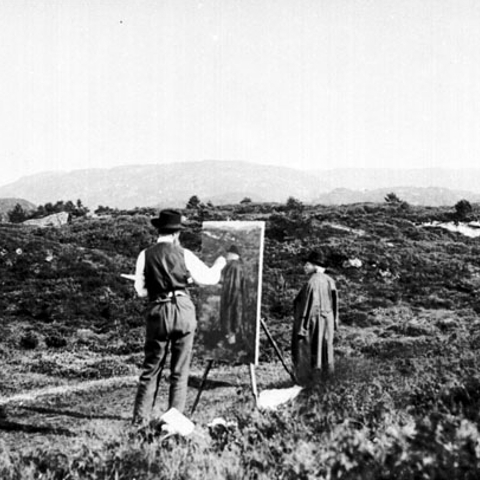
Erik Werenskiold and Edvard Grieg (1880), Edvard Grieg Museum.
-
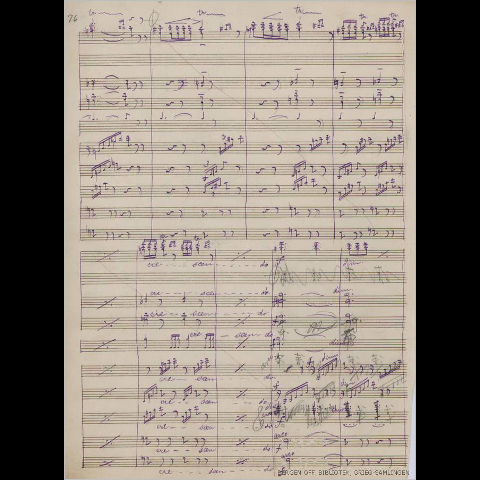
Fragment of Edvard Grieg manuscript, Bergen Offentlige Bibliotek.
-
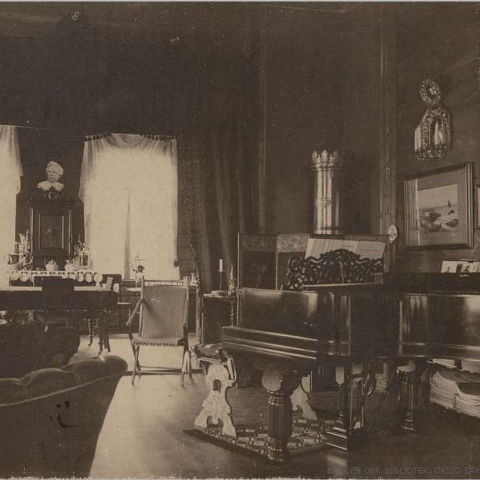
Interior of the villa, living and dining room (1892), Bergen Offentlige Bibliotek.
-
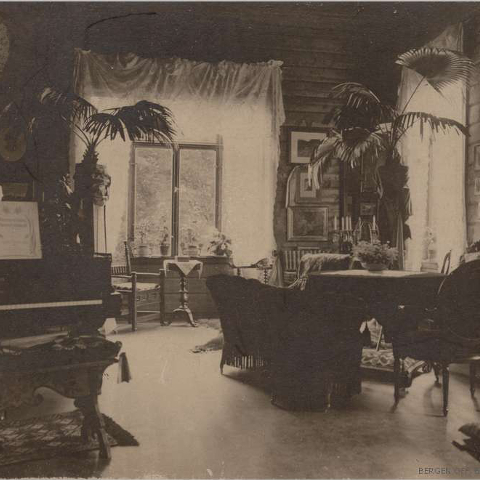
Interior of the villa, living room (1892), Bergen Offentlige Bibliotek.
-
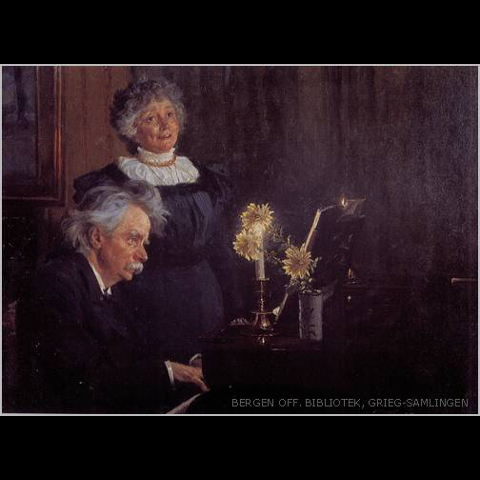
Nina and Edvard Grieg at the piano, portrait (1899), Bergen Offentlige Bibliotek.
-
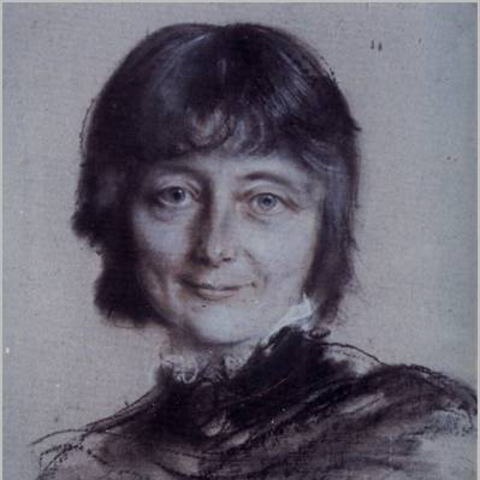
Nina Grieg, portrait by Franz von Lehbach (1884), Bergen Offentlige Bibliotek.